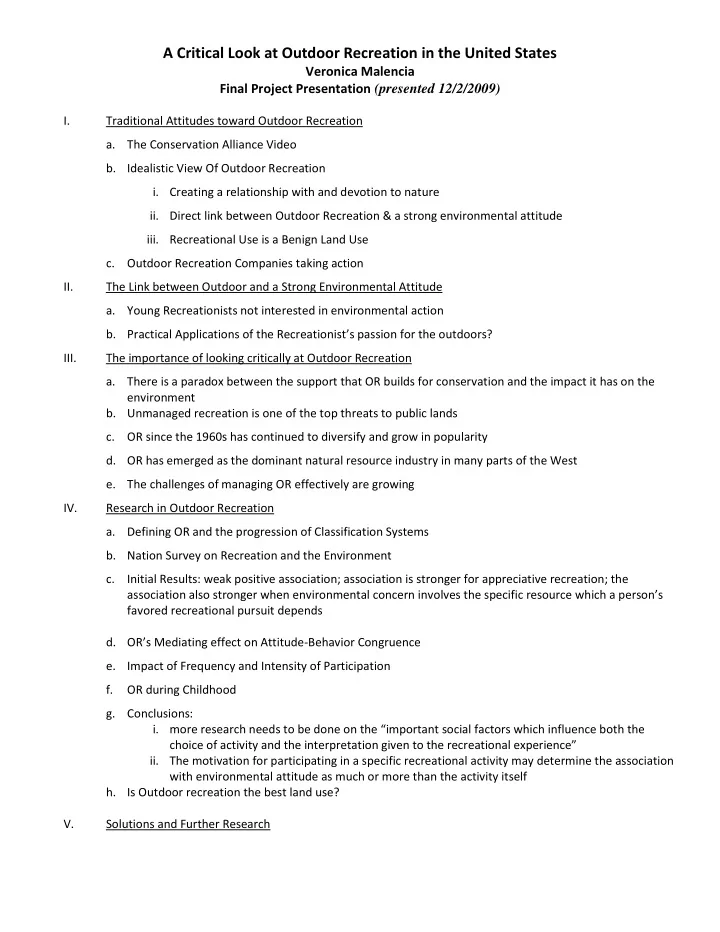

A Critical Look at Outdoor Recreation in the United States Veronica Malencia Final Project Presentation (presented 12/2/2009) I. Traditional Attitudes toward Outdoor Recreation a. The Conservation Alliance Video b. Idealistic View Of Outdoor Recreation i. Creating a relationship with and devotion to nature ii. Direct link between Outdoor Recreation & a strong environmental attitude iii. Recreational Use is a Benign Land Use c. Outdoor Recreation Companies taking action II. The Link between Outdoor and a Strong Environmental Attitude a. Young Recreationists not interested in environmental action b. Practical Applications of the Recreationist’s passion for the outdoors? III. The importance of looking critically at Outdoor Recreation a. There is a paradox between the support that OR builds for conservation and the impact it has on the environment b. Unmanaged recreation is one of the top threats to public lands c. OR since the 1960s has continued to diversify and grow in popularity d. OR has emerged as the dominant natural resource industry in many parts of the West e. The challenges of managing OR effectively are growing IV. Research in Outdoor Recreation a. Defining OR and the progression of Classification Systems b. Nation Survey on Recreation and the Environment c. Initial Results: weak positive association; association is stronger for appreciative recreation; the association also stronger when environmental concern involves the specific resource which a person’s favored recreational pursuit depends d. OR’s Mediating effect on Attitude -Behavior Congruence e. Impact of Frequency and Intensity of Participation f. OR during Childhood g. Conclusions: i. more research needs to be done on the “important social factors which influence both the choice of activity and the interpretation given to the recreational experience” ii. The motivation for participating in a specific recreational activity may determine the association with environmental attitude as much or more than the activity itself h. Is Outdoor recreation the best land use? V. Solutions and Further Research
Brief Project Overview My presentation examined the role of outdoor recreation in the United States by taking a critical look the traditional views that American ’ s hold towards outdoor recreation and the actual consequences associated with it. The major assumption that I looked at in the presentation was that ‘ there is a direct relationship between participation in outdoor recreation and a strong conservation ethic ’ . I approached this OR myth by first showing a video that exemplified the attitude that participation in activities such as rock climbing creates a love, appreciation, and dedication to nature. I also talked about an outdoor outfitter company, Patagonia, that illustrates the OR stereotype because it is actively involved in a lot of environmental action and sustainable behaviors. Then through the use of magazine articles, web postings and peer-reviewed journal articles I proceeded to break down this stereotype. ‘ Conservation for an Adrenaline Crowd ’ looked at young recreationalists and their lack of enthusiasm towards environmental action. An interview at the end demonstrated the divide that many recreationalists have between their passion for their sport and the environment in which they participate in, and the need to put that passion into any practical form of action to preserve these environments. The scholarly research further accentuated this point. Studies showed that there is a weak link between OR participation and strong environmental attitudes and that this association was greater when the type of recreation was an appreciative type. Yet an overview of the studies from the past 40 years presented mixed results. OR participation did seem to increase the connection between attitudes and behaviors towards the environment. Outdoor recreational activities as a child were also a common factor seen in many leaders in the environmental movement. There were also differences found among different types of recreation as well as frequency and intensity of participation, and researchers were able to build off of past work to better categorize and analyze data. The main conclusion is that although there is some association, it is not enough to assume any amount of causation. More research needs to be done on social factors that influence the activity an individual chooses and the interpretation he gives to the recreational experience. It may be that the real association with a conservation ethic comes from the motivation behind participating in a recreational activity and not necessarily the activity itself. My presentation also examined another major assumption about outdoor recreation. This assumption states that outdoor recreation is a benign use of land and thus is the ideal way to preserve wild spaces. I contradicted this statement by providing information about the negative effects that OR activities have on the biota and wild species. Research in conservation biology has shown that these activities, even the ones label ‘ appreciative ’ are not lacking in environmental impact. I discussed both possible solutions and conclusions that can be gathered from all of this information and I also explained the importance of looking critically at outdoor recreation. OR activities have not only diversified and grown in popularity over the last 40 years, they have also become a major industry for the Western United States . Therefore because it is not a profitable business, it also is at risk to be exploited. And when OR is exploited, so is the wildlife areas where these activities take place. Ultimately this presentation ’ s purpose was to break down the myths of outdoor recreation and provide a warning that these activities could be a threat to the future of the public lands in the Western United States if proper management isn ’ t taken to reduce its impact on the environment.
Recommend
More recommend